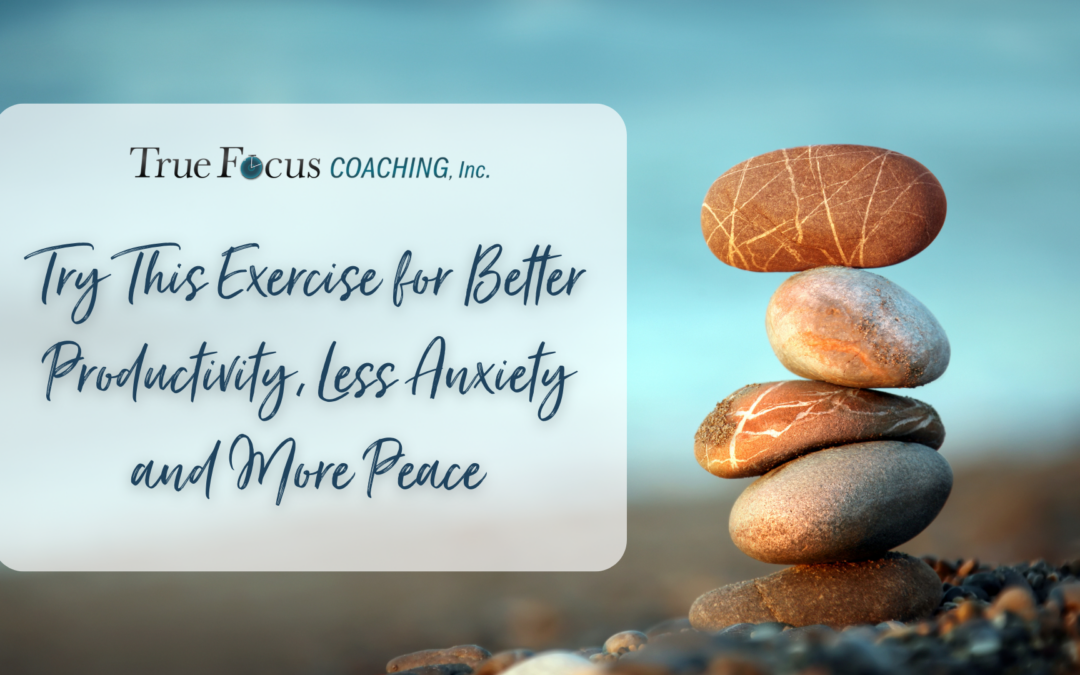Productivity
It’s stressful out there!
Between the tense state of our country post-election, and the upcoming stress of Thanksgiving and the end-of-the-year push, a lot of people are struggling to keep it together right now.
“Keep it together” could work as a baseline goal on an extra brutal day when your mind is spinning and you’re being pulled in a hundred directions. But you’re probably not living your best life or doing your best work or managing your time well when you’re in stressed-out survival mode.
The Role of Coping Strategies in Sustaining Productivity
Lately we’ve talked a lot about fears and anxieties. Navigating those is a part of good time management and productivity no matter what’s going on in the world or in your personal life. Anxiety and stress are probably going to keep showing up for you over the next few months. Holidays can mean travel stress, money stress and now maybe tense election talk with family too. And you’ll have to keep managing the day-to-day work of your business, while handling all the year-end stuff and preparing for next year.
You need coping strategies to protect your peace and quiet down the fear voices right now. Not only for the good of your mental health, but to create space for peak productivity. It gets hard to focus on good time management and prioritizing your tasks well when you’re distracted by anxiety and fear.
So now’s the perfect time to talk about an exercise that can help handle those fears and quiet some of your stress.
I like to call it the “what went well?” conversation.
The concept is simple, but can have a powerful impact on your sense of well-being in a way that could actually improve your time management.
The Science Behind Positive Reflection
There’s actual evidence that focusing on things that have gone well recently can boost mental health. Back in 2005, Dr. Martin Seligman, a well-known leader in the field of positive psychology, published findings from a study about something he called “the three blessings” project, also known as the “three good things” project.
It was a super simple idea. Dr. Seligman and his research team had participants sit down at the end of the day to write down three good things that had happened to them that day. After just one week, participants reported higher levels of well-being and lower levels of depression. Some people continued the exercise after that first week and reported increased happiness and decreased depression in a 6-month follow-up visit. Dr. Seligman also ran a similar study with severely depressed participants, and 94 percent of them had significant improvement in depression symptoms after 15 days of doing the exercise.
How This Connects to Better Time Management & Productivity
Here’s the tie-in to better time management as we move into the chaotic end-of-year push:
If you’ve worked with me before, you might already know that I strongly believe in celebrating your wins, big and small. It forces a mindset shift. Instead of focusing on all the stuff you haven’t gotten done, or things that are going wrong, you’re forced to look at your day through a positive lens.
Noticing the things that have gone well reminds you how competent you are and gets you excited about your work. It’s an opportunity to reflect on what actions you took that led to those positive results. You’ve already handled X, Y and Z well, and you can keep building momentum on those things moving forward.
I love having the “what went well?” conversation one-on-one as part of productivity coaching, but you can absolutely do this exercise on your own.
Try it anytime you’re feeling anxious or uncertain about what to do next. But adopting it as part of your daily schedule could be worthwhile, too. A positive perspective shift can be soothing when you’re stressed out. If you’re stressed every day, you need coping strategies every day too.
3 Steps to the “What Went Well” Exercise
- Build “what went well” time into your evening routine. Maybe it’s something you start brainstorming when you’re brushing your teeth at night, for example. Tie this exercise to something you already do every evening so you don’t have to remind yourself to do it.
- Write down three things that went well at work or in your personal life that day. Choose at least three wins that were directly related to your efforts, like “had a promising conversation with a prospective client” or “actually left work on time to go to the gym like I wanted to.” If you want to expand your list to celebrate good things that happened to your family or in your community, go for it—but make sure you notice at least three things that you did well.
- Notice the specific actions you took that led to those wins. Go through them one by one. What steps did you take before and during that client call that made it go so well? What time management strategies did you use that made you feel good about ending your workday right at 5 p.m. so you could go to the gym? Write down those actions, or just let those kinds of questions percolate as you wrap up your evening. Keep your answers in mind when you’re prioritizing your tasks the next day.
Time Management and Productivity Support
I’m here with the time management and productivity support you crave.
Reach out to me any time to talk more about what kind of time challenges you’re struggling with and how I could help.
And realtors: Join me on December 5th at 12ET for a no-cost webinar on Year-End Time Management Strategies for Realtors. Get a grip on your time right now so you can keep growing your business and actually enjoy the upcoming holiday season as much as possible.
Be well,
Sarah
- Try This Exercise for Better Productivity, Less Anxiety and More Peace - November 15, 2024
- Anxious About Preparing for Year-End? Don’t Let Fear Derail Productivity - October 30, 2024
- Year-End Time Management: What Could You Accomplish in 2 Months? - October 15, 2024



